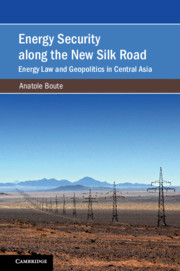Book contents
- Energy Security along the New Silk Road
- Cambridge Studies on Environment, Energy and Natural Resources Governance
- Energy Security along the New Silk Road
- Copyright page
- Dedication
- Contents
- Figures
- Map
- Preface and Acknowledgements
- Abbreviations
- 1 Introduction
- 2 Central Asian Energy Security
- 3 Regional Energy Market Reform
- 4 Corporate Restructuring Reform
- 5 Reform of the Energy Market Architecture
- 6 Tariff Reforms
- 7 Market Reform, Consumer Protection and Energy Efficiency
- 8 Non-payment and Theft
- 9 Conclusion
- Select Bibliography
- Index
3 - Regional Energy Market Reform
Published online by Cambridge University Press: 04 June 2019
- Energy Security along the New Silk Road
- Cambridge Studies on Environment, Energy and Natural Resources Governance
- Energy Security along the New Silk Road
- Copyright page
- Dedication
- Contents
- Figures
- Map
- Preface and Acknowledgements
- Abbreviations
- 1 Introduction
- 2 Central Asian Energy Security
- 3 Regional Energy Market Reform
- 4 Corporate Restructuring Reform
- 5 Reform of the Energy Market Architecture
- 6 Tariff Reforms
- 7 Market Reform, Consumer Protection and Energy Efficiency
- 8 Non-payment and Theft
- 9 Conclusion
- Select Bibliography
- Index
Summary
Building on the energy law literature on regional market integration, Chapter 3 focuses on the regional dimension of energy market reform in Central Asia. Energy security does not equate with energy self-sufficiency. Given the uneven distribution of resources and the high cost of energy self-sufficiency, states are often bound to cooperate with each other to ensure the security of their energy supplies. Because the Central Asian energy infrastructure was developed during the Soviet era without regard to state borders, the collapse of the Soviet Union had a significant impact on the region’s energy security. As distrust and geopolitical tensions built up, the Central Asian states started to prioritize national energy independence and to focus on the security of their individual national energy systems, at the expense of regional integration. Chapter 3 discusses Central Asian energy market integration agreements and critically reflects on the institutional constraints on the implementation of these agreements (e.g., the lack of trust between the parties, the political sensitivity of energy pricing and the geopolitics of energy in the region).
Keywords
- Type
- Chapter
- Information
- Energy Security along the New Silk RoadEnergy Law and Geopolitics in Central Asia, pp. 65 - 99Publisher: Cambridge University PressPrint publication year: 2019

